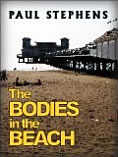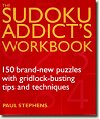Random Sudoku
@paulspages.co.uk
How to solve sudoku puzzles
Solving sudoku puzzles is easier
than it looks, and all but the very hardest puzzles can be solved using just a
few simple techniques. You don't need any maths, and you don't need to guess.
It's all done by observation and logic, and the most important thing is to stay
100% accurate at all times.
This page covers techniques that
will solve most puzzles up to (and including) 'fiendish' or 'very hard' rating.
If
you've arrived here direct from a search engine, you may like to try
sudoku@paulspages.co.uk - it's a web page that
creates puzzles, lets you solve them on screen (or print them out) and will even
show you the answer!
Click here
for a printer-friendly version of this page.
For an expanded version of this guide, including more extreme
solving methods, see
SudokuXP's Solving Guide.
1. The Rules.
2. Getting started.
3. Pencilling-in.
4. Serious solving!
5. Extreme puzzles.
6. Quick solving checklist.
1. The Rules.

Here's a 'classical' sudoku puzzle. It's a
grid 9 squares wide and 9 squares deep. The lines of squares running
horizontally are called rows, and the lines running vertically are called
columns. The grid is further divided by the darker lines into nine 3 X 3 square
'boxes'.
Some of the squares already have numbers in them. Your task is to fill in the
blank squares. There's only one rule:
This rule has an important side-effect,
which is the basis of all solving techniques:
2. Getting started.
Solving sudoku is all about eliminating
the impossible. It's also about looking at the same thing in different ways.
◊ The crosshatching and
slicing/dicing techniques shown in the first part of this page are enough, on
their own, to solve most easy puzzles. If you're new to sudoku, it's worth
generating some easy puzzles and practising these techniques.
To solve more difficult puzzles you need to use crosshatching in combination
with other techniques. These are described in the second part of this page.
Crosshatching - finding squares for numbers.
The obvious way to solve a sudoku puzzle is to find the right numbers
to go in the squares. However the best way to start is the other way round -
finding the right squares to hold the numbers.
This uses a technique called 'crosshatching', which
only takes a couple of minutes to learn. It can solve many 'easy' rated puzzles
on its own.
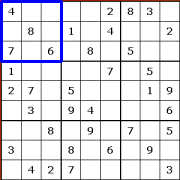
Crosshatching works in boxes (the 3 X 3 square
subdivisions of the grid). Look at the top-left box of our sample puzzle
(outlined in blue). It has five empty squares. All the numbers from 1 to 9 must
appear in the box, so the missing numbers are 1,2,3,5 and 9.
We'll ignore 1 for a moment (because it doesn't
provided a good example!), and see if we can work out which square the missing 2
will go into.
To do this, we'll use the fact that a number can
only appear once in any row or column. We start by looking across the rows that
run through this box, to see if any of them already contain a 2. Here's the
result:
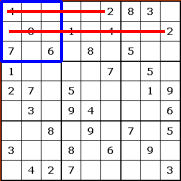
Bingo! The first two rows already contain
2s, which means that squares in those rows can't possibly contain the 2 for this
box. That's all we need to know, because the third row only has one empty
square, so that must be the home for the 2.
Now let's see if we can place the 3 for
this box. This time we end up checking the columns that run down through the
box, as well as the rows that run across it:
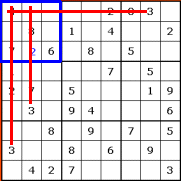
Again, we get a result first time -
there's only one empty square that the 3 can possibly go into. You can see from
this example why it's called 'crosshatching' - the lines from rows and columns
outside the square criss-cross each other.
Of course you don't always get a result
first time. Here's what happens when we try to place the 5:
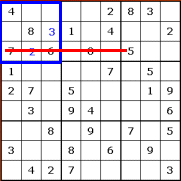
There's only one 5 already in the rows and
columns that run through this box. That leaves three empty squares as possible
homes for the 5. For the time being, this box's 5 (and its 1 and 9) have to
remain unsolved.
Now we move on to the next box:
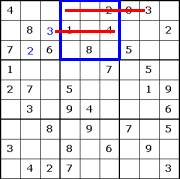
Here we're crosshatching for 3, the first missing
number in this box. Note how we treat the 3 we placed in the first box as if it
had been pre-printed on the puzzle. We still can't place this box's 3 though, so
we'll move on to the next missing number (5), and so on.
◊ In sudoku, accuracy is
essential. If the 3 in the first box is wrong, we'll be starting a chain of
errors that may prove impossible to unravel. Only place a number when you can
prove, logically, that it belongs there. Never guess, and never follow
hunches!
An important factor in crosshatching (and
sudoku in general) is that the more numbers you place, the more likely you are
to place others - including ones you couldn't place earlier.
Placing numbers in the second box may well
make it possible to go back and place missing numbers in the first. It's good to
get into the habit of looking backwards as well as forwards, re-checking whether
the numbers you've just placed have made numbers placeable elsewhere in the
puzzle.
Slicing and dicing
In sudoku it pays to look at the same thing in
different ways. By using crosshatching slightly differently, you can often get
quicker results.
Instead of looking at a single box and its missing
numbers, you can look at a group of three boxes running across or down the
puzzle, trying to place each number from 1 to 9 in as many of the boxes as you
can.
In this example we're trying to place 7s
in the three right-hand boxes:

The stack of boxes starts out with just
one 7 in place (bottom box). This solves the middle box's 7 (entered in blue),
and entering that immediately solves the top box's 7 as well.
This 'chain reaction' of solving wouldn't
occur in single-box crosshatching. It happens here because we're focussing on a
single number across multiple boxes - looking at things differently.
Crosshatching and slicing/dicing are
basically the same thing, but slicing/dicing can be more efficient, and often
feels less laborious than doggedly working through the empty squares in a single
box (although that's what you will have to do in order to solve tough puzzles,
so be prepared!).
The right start...
It's a good idea to start any puzzle by
slicing and dicing, perhaps switching to single-box crosshatching if you get
stuck.
Most easy (and many moderate) puzzles can
be solved that way - just make a first 'pass' through the whole puzzle placing
all the numbers you can, then go back and start again, seeing if any more
numbers can now be placed. Keep doing that, and eventually you'll fill the whole
puzzle.
In practice you'll soon find that you stop
working in passes through the whole puzzle, and begin darting to whichever area
looks most likely to have solvable squares.
If you get stuck (i.e. you can't place any
more numbers), then it's worth making another methodical pass through the whole
puzzle. This will often reveal a solvable square you've missed.
... but when the going gets tough...
On tough puzzles crosshatching and
slicing/dicing will eventually run out of steam - you'll make a pass through the
whole puzzle without being able to place any more numbers.
When this happens it's time to switch to a
different approach, using the solving techniques described in the second part of
this page.
The first step, however, is more crosshatching. This
time you need to go through the entire puzzle, box by box, crosshatching each
box for all its missing numbers. As you do that, you make a note of which
squares each missing number can possibly go into. This is called 'pencilling
in'.
3. Pencilling in.
The solving techniques needed for more difficult
puzzles all depend on having an accurate list of the possible numbers (called
'candidates') for each empty square. You can build this list by pencilling the
candidates in as you make a complete crosshatching pass through the puzzle.
Looking at the top-left box of our original puzzle,
crosshatching produced three possible squares where the missing 5 could go.
Here's the box, with 5 'pencilled-in' to the corners of its three possible
squares:
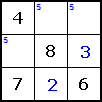
◊ (It's called 'pencilling-in'
because on a printed puzzle many people use a pencil, so that they can rub
numbers out later (an essential part of the solving process). On my sudoku page,
you click in the top-left corner of the square, then type and delete numbers
like a normal text box)
1 and 9 were also unsolved for this box.
Here's the box with all its missing numbers pencilled into their possible
squares:
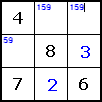
This list must be complete and accurate,
otherwise you risk creating another chain of errors. That's why it's essential
to crosshatch every missing number for every box before starting the next stage
of solving.
Candidate lists must also be kept up to
date (the reasons for this will become obvious later!). Here's what it means:
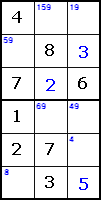
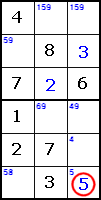
On the left is is the top-left box, and the one below it. We've
just entered a 5 in the bottom-right square of the lower box.
Now we remove that square's candidate list. We also remove 5 from
the candidate list at the top of the same column, and the left of the same row.
Here's how the boxes look afterwards:
Whenever you fill in a square, remove the number you've used from all candidate
lists in the same row, column and box. Here are the areas we needed to check for
candidate 5s after filling in this square:
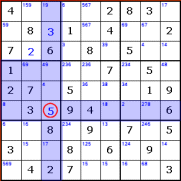
Don't worry if that looks complex - in
practice it's quick and easy to scan through the same row, column and box as the
square you've just filled.
When you're crosshatching the puzzle,
remember to update any candidate lists that are affected by numbers you place.
4. Serious Solving!
It's always worth starting the solving
process with a quick slice/dice, because it might solve a square or two even on
the toughest puzzle.
However if the puzzle is rated 'hard' or
tougher, crosshatching techniques will soon stop producing results. It's best to
cut your losses, do the full pencilling-in crosshatch, and move on to some
serious solving.
◊ In difficult puzzles with 26
or fewer starting squares, the initial crosshatching run will produce few solved
squares, and long lists of candidates. Don't be put off by this - the lists will
soon start to shorten as you apply the rules described below.
This part of the solving process is where
you switch approach and start finding numbers for squares instead of squares for
numbers. You do this by checking your pencilled-in candidate lists for a series
of rules (or 'candidate patterns'), and acting on them.
There are lots of rules (and more being
discovered all the time), but a basic set of five will solve most puzzles up to
'really tough' or 'fiendish' level. It's worth practicing these until you find
yourself recognising the patterns instinctively (it doesn't take long), then
adding more rules to your repertoire as they're needed.
Always remember that all rules depend
on your candidate lists being complete, accurate and up to date. Get them
wrong and you'll soon have big problems!
The first two rules let you solve squares
immediately.
Rule 1 - Single-candidate squares.
When a square has just one candidate,
that number goes into the square.
Here's the mid-left box again, as it was
before we entered the 5:
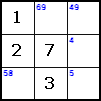
The mid-right and bottom-right squares
each have only one candidate, so we can put those numbers into the squares.
Some squares will be single-candidate from
the start of the puzzle. Most, however, will start with multiple candidates and
gradually reduce down to single-candidate status.
This will happen as you remove numbers
that you've placed in other squares in the same row, column and box, and as you
apply the last three rules described below.
Rule 2 - single-square candidates.
When a candidate number appears just
once in an area (row, column or box), that number goes into the square.
Look at the mid-left box again:

The number 6 only appears in one square's candidate
list within this box (top-middle). This must, therefore, be the right place for
the 6.
The remaining three rules let you remove numbers
from candidate lists, reducing them down towards meeting one of the first two
rules.
Rule 3 - number claiming.
When a candidate number only appears in one row
or column of a box, the box 'claims' that number within the entire row or
column.
Here's the top-left box again:

The number 1 only appears as a candidate in the top
row of the box. This means there will have to be a 1 somewhere in the first
three squares of the puzzle's first row (i.e. the ones that overlap with the
box). That in turn means that 1 can't go anywhere else in that row, outside of
this box.
You can read across the row, and remove 1 from any
candidate lists outside of this box, even though you haven't actually placed 1
yet.

In this example, we can remove the 1 from the
right-hand square's candidate list. This makes the square single-candidate (7) -
square solved!
Claims also work during crosshatching. Here we're
crosshatching the top-right box for 1:
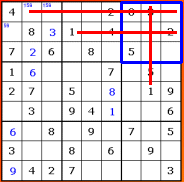
We can rule out the top row, because the top-left
box has already claimed that row's 1. This lets us place the 1 in the
bottom-right square of the box.
Rule 4 - pairs.
When two squares in the same area (row,
column or box) have identical two-number candidate lists, you can remove both
numbers from other candidate lists in that area.
Here's the second row of the puzzle:

Two of the squares have the same candidate
list - 67. This means that between them, they will use up the 6 and 7 for this
row.
That means that the other square can't
possibly contain a 6. We can remove the 6 from its candidate list, leaving just
9 - square solved!
The squares in a pair must have exactly two
candidates. If one of the above squares had been 679, it couldn't have been part
of a pair.
Rule 5 - triples.
Three squares in an area (row, column
or box) form a triple when:
You can remove numbers that appear in
the triple from other candidate lists in the same area.
Here's the fourth row of the puzzle:

Note the three squares in the middle, with
candidates of 23, 23 and 234. These form a triple.
234 is the full, three-candidate list, and
23 is a subset of it (i.e. all its numbers appear in the full list). Because
there are three squares, and none of them have any candidate numbers outside of
those in the three-candidate list, they must use up the three candidate numbers
(2, 3 and 4) between them.
This lets us remove the 4 from the other
two candidate lists in this row, solving their squares.
It's worth looking hard for subset
triples. In this example, the 23 lists make an obvious pair (see above), but
it's the triple that instantly solves the two outside squares (once you've
dispensed with them, you can treat the 23s as a pair again, and use them to
solve the 234!). A subset (or 'hidden') triple is often the pattern that will
unlock a seemingly impossible puzzle.
Note - the squares in a pair or
triple don't have to appear next to each other, or in any particular order. In
the example above, the triple could have occurred in, say, the first, third and
fifth empty squares of the row, with the 234 in the middle.
Perhaps surprisingly (OK, I was
surprised!) the triple rule can be true even if none of the squares have three
candidates. Take these three candidate lists:
13 16 36
All three lists are subsets of the list
136. Between them, these three squares will use up the 1, 3 and 6 for the area
they're in. These triples can be hard to spot though, so it's probably best to
start by looking out for three-candidate squares.
(Special thanks to Edward for pointing out
that the members of a triple can all be subsets of the full list!)
◊ If all-subset triples still
don't seem right, think of it this way:
The crucial thing is that the number of squares equals the number of candidates
in the full list (so three squares all with subsets of '136' (a three-candidate
list) makes a triple).
It doesn't matter if some (or all) of the squares don't have the full candidate
list. What matters is that between them they cover the list, the whole list and
nothing but the list. That means they must use up all three of the list's
numbers between them.
In case all that's put you off, here's an
example of a more obvious triple - they do exist!:

Pairs and triples are, in fact, variations of the
same pattern, sometimes called 'disjoint subsets'. We can express rule 5 in
general terms, like this:
A set of N squares in an area forms a group when:
- None of the squares has more than N candidates
- Their candidate lists are all full or sub sets of the same N-candidate list.
 Pairs (N=2)
with subset members tend not to survive long, because a subset of a two-number
list is a single candidate and thus solvable.
Pairs (N=2)
with subset members tend not to survive long, because a subset of a two-number
list is a single candidate and thus solvable.
However a single-candidate square can function perfectly well as a member of
a pair, or even a triple. This often has the same effect as solving the
single-candidate square then updating its surrounding candidate lists, but can
be quicker.
On the left is an example (and from an 'easy' rated puzzle, too!)
The top three unsolved squares, with candidates of
26, 23 and 2, form a triple (N=3) with a full list of 236.
That lets us remove the 3 and 6 from the bottom
square's candidate list, reducing it to just 8 - square solved!
You also sometimes see 'quadruplets' (N=4) - four
squares, none with more than four candidates, and all full or subsets of a
four-candidate list.
And, er, that's it....
Using complete, up-to-date candidate lists and the
five rules described above, you can solve all but the most extreme sudoku
puzzles (using these alone, it's normally possible to solve the 'fiendish'
puzzle in the Times newspaper on Fridays).
It's just a matter of scanning through the puzzle,
looking for the claim, single-square candidate or triple that will unlock the
next stage of the solution.
The harder the puzzle, the harder they tend to be to
find, and the fewer 'easy' pairs and single-candidate squares present
themselves. But the hard-to-spot rules are in there somewhere - you've just got
to find them!
The keys to successful solving are:
-
Total accuracy - never put a number in a square or
candidate list unless you're absolutely sure it's right.
-
Completeness - make sure to crosshatch every missing
number in every box, so that you start the second stage of solving with complete
candidate lists.
-
Maintenance - whenever you place a number in a
square, update all the candidate lists in the same row, column and box, straight
away (this includes numbers placed during crosshatching).
5. Extreme puzzles.
If the rules described above won't solve a
puzzle, then there are two possibilities:
-
It's a genuinely extreme, but solvable,
puzzle, which requires extra rules to solve. In very extreme cases this may
involve an element of guesswork (although many people don't regard such puzzles
as 'proper' sudoku).
-
It's not a genuine sudoku puzzle, because
it either:
a. Has more than one possible solution, requiring you to make guesses in order
to find one of them. (Note that this isn't the same as a single-solution puzzle
that requires guesswork - although it may seem pretty similar!)
b. Doesn't have a solution at all.
To check whether a puzzle has more than one
solution, type or import it into my page (instructions on page), then press
'Check My Answer'.
Note - if my page gives a puzzle a rating
other than 'outlaw', then it's guaranteed to be solvable by logic alone, with no
guesses required.
Assuming the puzzle is genuine, a good place to
start is with rules 6 and 7 (yes, there are rules 6 and 7!). Here they are:
Rule 6 - excluded candidates.
Within an area (row, column or box), when a set
of N candidate lists contain all occurrences of a set of N candidate numbers,
other numbers can be removed from those lists.
Note that N is the same both times, so it's three
lists containing all occurrences of the same three candidates, and so on.
Here's a (hypothetical) example:

The group comprises squares 1, 2 and 5.
All three include the candidates 4, 5 and 7 (three squares, three candidates),
and those candidates don't appear in any other lists in this row.
This means that between them, these three
squares claim the 4, 5 and 7 for this row. It also means they can't possibly
hold any numbers other than 4, 5 or 7.
This lets us remove the other candidate
numbers from these squares, like this:

This turns square 6 (18) into the only
square with candidate 1, thus solving the square. (Incidentally, there's another
way to solve square 6 in this row - can you spot it?)
This rule works with subsets. For example,
if the row looked like this:

Square 2's list doesn't contain a 5, but
squares 1,2 and 5 still form a valid group. This is because these three squares
will still, between them, have to hold the 4, 5 and 7 for this row. Groups like
this are just a little bit hard to spot though!
The important thing when looking for this
pattern is to make sure none of the candidates appear anywhere else in the area.
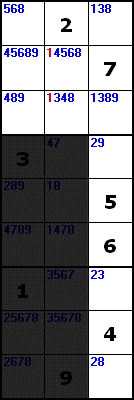 Rule
7 - box line reduction.
Rule
7 - box line reduction.
(Note - I found this rule at
Scanraid's
excellent solver site).
If all occurrences of a candidate within a row or
column fall inside the same box, then other occurrences of that candidate can be
removed from that box.
In the right-hand column of this example (not from
the sample puzzle), all the occurrences of candidate 1 are in the top box.
This means that the 1 for this box must go in that
column, so we can remove 1s from other candidate lists in that box.
This rule is the reverse of rule 3 (number claiming)
- instead of the box claiming the number within the row/column, the row/column
claims the number within the box.
What if I still can't solve it?
If the puzzle still won't budge, and
you're confident that it's valid, then you'll need to enter the exotic world of
X Wings, Swordfish and Nishio.
X Wing and Swordfish are patterns that span multiple
rows and columns, claiming a candidate number that can then be eliminated from
other lists in the relevant columns/rows. They're (fairly) easy to understand
but very hard to spot.
Nishio is controversial, as some people
regard it as guesswork (you try a number and see if it leads to a dead end) and
therefore not proper, logical sudoku solving.
The best explanations I've seen of these
patterns are in
Simon Armstrong's and
Angus
Johnson's sudoku solving guides. They describe all the other techniques too,
and Simon's was where I discovered the excluded candidates rule. Thanks!
One other (rare) possibility is the remote
pair, which is surprisingly simple once you get to grips with it. It's described
at
http://www.scanraid.com/RemotePairs.htm.
It's worth remembering that spotting these patterns
(or using Nishios) is only essential in a small minority of genuinely extreme
puzzles. Most puzzles, even 'really tough' and 'fiendish' ones, can be solved by
finding every last triple, claim and so on.
Yes, but what about guessing?
Guessing is, in fact, one of the quickest
and simplest ways to solve a sudoku - if you're a computer. If you're not, then
it's best avoided if at all possible.
Guessing should only be used near the end
of a puzzle, when there are 12 or fewer squares left to solve (and preferably 6
or fewer). Any earlier, and it's more likely that either the puzzle is invalid,
or you've missed something.
If the puzzle is printed and you've got a
photocopier, make a copy (including your solution so far) and work on that. If
you're using my page, press 'Save Bookmark' (or export the puzzle as text, copy
it to the clipboard and save it via a text editor).
Now find a square with just two candidates
(any more and you're asking for trouble!). Choose one of the candidates and
pencil it into the square.
The first thing to do is check whether your guess has made the puzzle
unsolvable. Update all the candidate lists in the same row, column and box, plus
any others that are affected as a result (for example, because a pair or triple
has now emerged). Then check the whole puzzle for the following:
If any of these occur, then your guess was
wrong. Restore your puzzle to its previous state (scrap your copy or press
'restore bookmark'), then try the other candidate as your guess - it should be
correct (if it's not, then you've got bigger problems!).
Unfortunately the fact that a guess isn't
immediately proved wrong doesn't necessarily mean that it's right. You'll have
to go on solving, keeping an eye out for the signs that the puzzle has now
become unsolvable.
This is why guessing is best kept to the
last stages of the puzzle, where the pathway to either a solution or a dead end
is relatively short.
Extra tips - checking that everything's
still correct.
Sometimes you might suspect that errors have crept
into your candidate lists. One way to check is to re-crosshatch the box where
you think the error is, crosshatching for all its missing numbers.
There is, however, another way to check
how many candidates a square has. Just read through the row, column and box it
belongs to, crossing off all the numbers that appear in them (including any
claimed numbers, as long as you're completely sure of them). The numbers that
don't appear are that square's candidates.
Here's the whole puzzle, with the row,
column and box relevant to the square at row 2, column 1 highlighted:
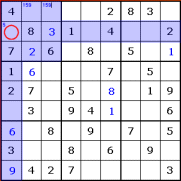
Check off the numbers that already appear
in these areas, and you'll find the list reads 1,2,3,4,6,7,8,9 - only 5 is
missing.
This technique (like crosshatching) will
only restore the starting value of a candidates list, not any reductions you'd
found by applying the rules described above.
Errors in candidate lists are relatively easy to
deal with. Errors in placed numbers are much more dangerous, because they can
corrupt all the candidate-list calculations around them. Always double (or
triple) check that a number is right before placing it as a square's value. If
you want to avoid serious headaches, never guess!
6. Quick Solving Checklist
Here's a quick checklist of the solving
plan for tough puzzles.
1. Try slicing and dicing to solve
any easy squares. Don't spend too long on it though.
2. Crosshatch the entire puzzle
box-by-box, pencilling-in complete candidate lists.
3. Scan the puzzle for the
following rules:
-
Single-candidate squares - solve
immediately
-
Single-square candidates within an
area (row/column/box) - solve immediately.
-
Claims by a box - remove the
claimed candidate from the same row/column in other boxes.
-
Pairs within an area - remove the
pair squares' candidates from other lists within that area.
-
Triples within an area - remove the
triple candidates from others lists within that area.
4. Whenever you solve a square,
immediately check and update all candidate lists in the same row, column and
box.
5. Whenever you've updated a candidate
list, check to see if one of the rules now applies (e.g. you've created a
triple, or a box is now claiming a number).
6. Never guess! (Unless you're
absolutely sure you have to!)
Have fun!
Paul Stephens, June 2005.
© Paul Stephens, 2005. All rights
reserved.
